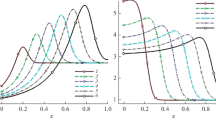Abstract
High order implicit methods are constructed for the solution of first order hyperbolic systems of PDE. The methods are based on the deferred correction principle in both space and time, and require only p/2 stages at each timestep for achieving accuracy of order p. Furthermore, they are suitable for applying domain decomposition techniques for implementation on parallel computers.
Similar content being viewed by others
REFERENCES
Carpenter, M., Gottlieb, D., Abarbanel, S., and Don, W.-S. (1995). The theoretical accuracy of Runge-Kutta time discretizations for the initial boundary value problem: A study of the boundary error. SIAM J. Sci. Comput. 16, 1241–1252.
Gustafsson, B., and Hemmingsson-Frändén, L. (2000). Implicit high-order difference methods and domain decomposition for hyperbolic problems. Appl. Numer. Math. 33, 493–500.
Gustafsson, B., and Kress, W. (2001). Deferred correction methods for initial value problems. BIT 41, 986–995.
Hairer, E., and Wanner, G. (1991). Solving Ordinary Differential Equations II, Springer-Verlag, Berlin.
Hemmingsson, L. (1995). A domain decomposition method for first-order PDEs. SIAM J. Matrix Anal. Appl. 16, 1241–1267.
Author information
Authors and Affiliations
Rights and permissions
About this article
Cite this article
Gustafsson, B., Hemmingsson-Frändén, L. Deferred Correction in Space and Time. Journal of Scientific Computing 17, 541–550 (2002). https://doi.org/10.1023/A:1015114412222
Issue Date:
DOI: https://doi.org/10.1023/A:1015114412222




